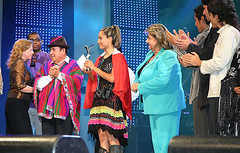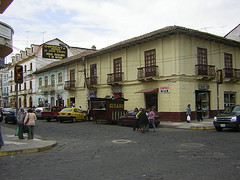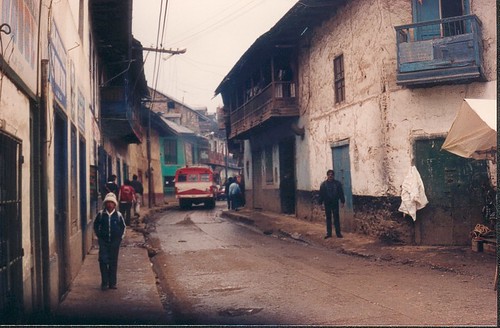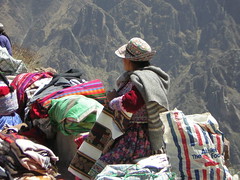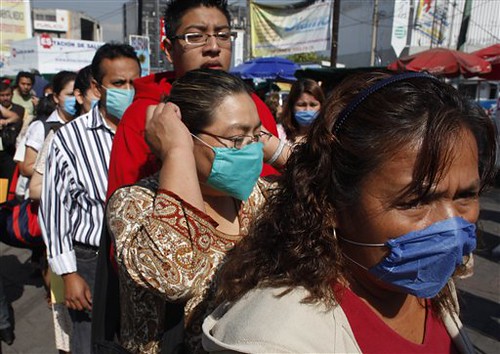Ecuador: Alien visits the Incas
A local woman was walking up the same mountain and confirmed that the Pan-American (a road from Chile to Alaska) was indeed at the top. The walk was arduous but we did make it – and faster than anyone else as they kept to the main path whilst we were led through a short cut. We were finally on the most important road in the Americas where we could flag down a bus to anywhere we wanted. We wandered along this heavily transited highway a while, finding it strangely empty. But before long a bus finally came by. We flagged it down and got on.
You must bare in mind that we were in the middle of nowhere – locals didn’t hail a bus from where we did let alone tourists. There weren’t many, if any, tourists wandering around these parts either. When getting on the bus, Annett sat in the seat next to the driver. With nowhere else to sit, the guy who takes ticket money struggled to find me somewhere. Eventually a space was made, right at the back of the bus, and he lead me from the separate drivers cabin through the door into the passenger compartment.
Silence fell. Eyes shot forward. Mouths dropped.
The people were in the company of an extraterrestrial being.
Me.
As I walked along the passage, politely greeting each person staring at me with a Buenos Dias and receiving the same back from now smiling faces, there were hushed discussions in the local language, Kichua, mixed with bouts of laughter and the word Gringo. When I sat down dozens of intrigued heads spun round and eyes were still on me. I then realised who I was sitting next to. It was the young Japanese man I had seen on the same train. He must have arrived up the hill just after us and boarded the bus moments before while we were walking.
The local talkative guy, a man of mid-twenties who was always smiling, had already begun interrogating the Japanese tourist who didn’t speak a word of Spanish and had to guess his way through the barrage of questions with just si and no. I was undecided as to whether to aid my fellow traveller with assistance and risk interrogation myself – but when the local guy started practising his one word of Japanese – Fujimori – the surname of the ex-President of Peru, I realised maybe I was missing out on some fun.
I asked our new Ecuadorian friend what more he knew of Japanese other than “Fujimori Sayonara Mitsubishi“. My Japanese friend started laughing out loud and the Ecuadorian, confused, calmly explained that his Japanese is limited to Fujimori.
Working as a translator for the Japanese tourist we answered questions about how long we had been here, where we had been and where we were planning to go. The Japanese was going directly to Cuenca whilst I was eager to stop off in Ingapirca, also in the middle of nowhere, to see some not often visited Inca ruins. He couldn’t be persuaded to join Annett and I, explaining that he was too tired.
The local on the other hand was intrigued about the Inca ruins and asked more, never having seen them. Rather than tell him, I decided to show him a photo from the guidebook in my bag. As I began to open the bag, silence fell once more and heads spun round. Slowly from the corner of my vision a woman’s head entered view, and stopped in my sights. She was hanging about 60cm over my lap where my bag was.
Everyone wanted to know what an extraterrestrial carried around with them and something like politeness wasn’t going to get in the way of this tremendous moment when they would find out.
As I pulled out the shiny brightly coloured guidebook, sleeping passengers were nudged and awoken. “What is that, your bible?“, said my new Ecuadorian friend having never seen a book of such quality that wasn’t a bible. Government school books, the only books other than a bible they have seen, are black and white on low quality paper. Before I could explain he noticed the maps inside, and keen to impress, declared proudly to the bus passengers that is was a book to orientarse, to orientate one’s self. Yes I said, having found the photo of the ruins and showing it to him and to the nearest people.
Answering his questions about myself he assumed I was from Lima as I lived there. He asked how long it would take and how much it might cost to travel there. I told him and to my surprise he said it was quite cheap. He obviously has more money than I do. The number of hours in bus did surprise him – Ecuador is quite small. He jokingly asked if I could invite him to come and see Lima, invite being a word that suggests you will pay in Spanish. “Sure“, I said, “though if you don’t have any money you’ll have to run alongside my bus“. This prompted a chuckle from those in the seats in front.
Asking my new friend how much further to Alausí, the bus entered a main street and came to a stop. We were here.
In Alausí we still had a two hour journey to reach the Inca and Cañari ruins, and from there a two hour journey to Cuenca. After walking to the top of a large hill, the one I had just sent my Japanese companion up to catch the bus to Cuenca before realising it would be the same bus to Ingapirca via Cañar or El Tambo, Annett and I purchased our tickets from the office. The bus arrived within minutes – this one half full of tourists and half full less remote locals more used to seeing them. Next stop, El Tambo.
Tags: ecuador



